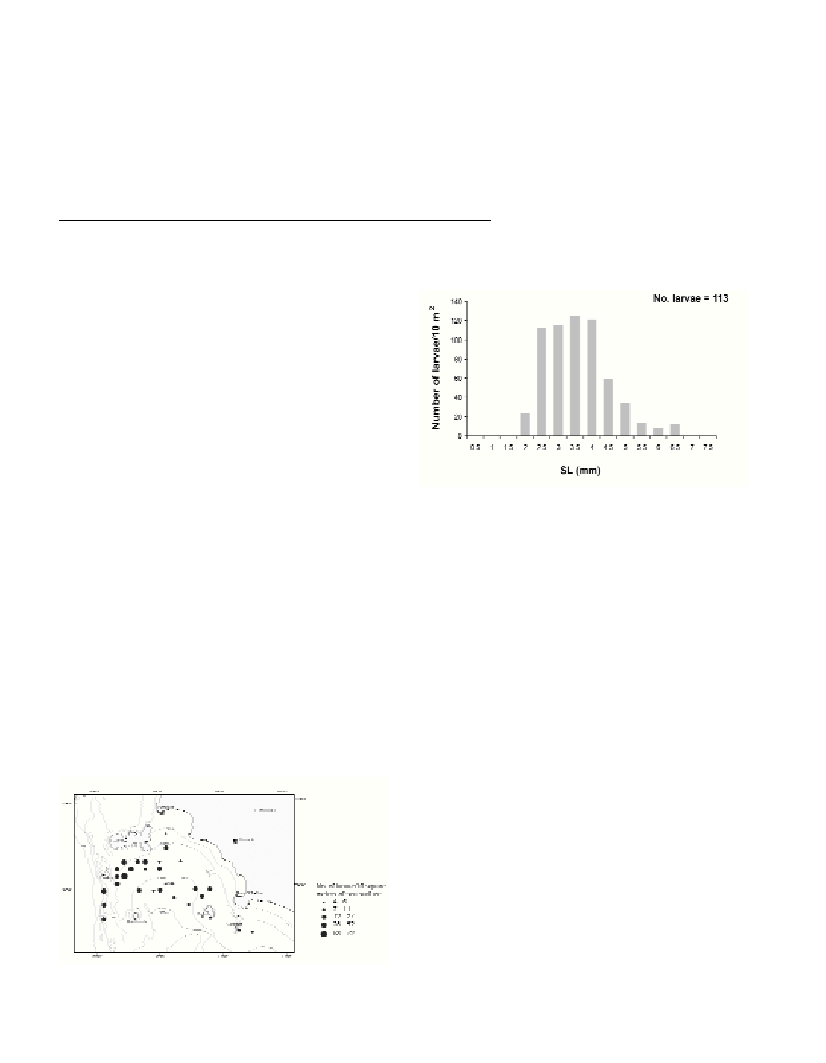OCCURRENCE OF CORIS JULIS(LINNAEUS, 1758) LARVAE
IN THE SOUTHERN TUSCAN ARCHIPELAGO
Sartini M.
1
, Belcari P.
2*
1
Aplysia p.s.c.r.l., Livorno, Italia - aplysia1@libero.it
2
Dipartimento di Scienze dell’Uomo e dell’Ambiente, Università di Pisa, Italia
Abstract
Distribution, abundance and size structure of Coris julislarvae were analysed. Data were collected during three ichthyoplankton cruises
carried out in the southern Tuscan Archipelago (northern Tyrrhenian Sea) in 1999 and 2000. C. julislarvae were only collected during
June, showing a wide distribution on the continental shelf.
Keywords: Ichthyoplankton, larvae, distribution, abundance, northern Tyrrhenian Sea
Rapp. Comm. int. Mer Médit., 37,2004
435
Introduction
The rainbow wrasse, Coris julis(Labridae),is the most common
and abundant wrasse in the Mediterranean, especially in its western
basin. The species lives on Posidoniabeds as well as rocky and mixed
bottoms, from few meters to 120-150 m depth, but it is more frequent
in waters shallower than 50 m (1). It is a by-catch of the inshore trawl
and of trap and angling fisheries. Some biological aspects of C. julis
have not yet deeply investigated, probably because of the lack of com-
mercial value of the species. The aim of this study was to give some
information on the abundance, distribution and size structure of
C.julislarvae collected in the southern Tuscan Archipelago.
Material and methods
In the southern Tuscan Archipelago, northern Tyrrhenian Sea, three
ichthyoplankton cruises were carried out in March 1999 and March
and June 2000 (2). During each cruise, a minimum of 60 stations were
occupied, collecting a total of 210 samples. Larvae were sampled by
means of oblique hauls, from near the bottom to the surface. A Bongo
net with 60 cm mouth diameter and 500
µ
m mesh size was used.
Sampling methodology followed standard procedures (3). Larvae of
C. juliswere identified according to morphological, morphometric
and pigmentation features (4). In addition, the standard length (SL, to
the nearest 0.1 mm) was measured for each specimen. Larval abun-
dance was standardised to the volume of filtered water at each station
and was expressed as number of larvae/10 m
2
of sea surface (3).
Results and discussion
In the ichthyoplankton survey carried out in June 2000, 113 larvae
of C. juliswere collected, whereas during the cruises of March 1999
and March 2000 no C. julislarvae were collected. This is in agreement
with existing knowledge of the reproductive period of the species
which occurs in late spring-early summer (5).
C. julislarvae presented a wide spatial distribution (Fig. 1). The
majority of stations at which they were found were localized between
50 and 200 m, in accordance with the ecological characteristics of the
adults. The presence of larvae at stations deeper than 200 m could be
related to advection by sea currents in the study area (6).
The maximum abundance of C. julis(72 larvae/10 m
2
) was record-
ed below the Island of Elba, near the Island of Pianosa; the minimum
abundance (4 larvae/10 m
2
) was found at stations located near the
Islands of Giglio and Giannutri (Fig. 1).
The size of the larvae ranged from 2.04 to 6.56 mm SL (Fig. 2).
Most specimens (about 76%) were between 2.5 and 4 mm SL, with a
mode at 3.5 mm SL.
References
1-Quignard J.P., Pras A., 1986. Labridae. Pp. 919-942. In: Whitehead
P.J.P., Bauchot M.-L., Hureau J.C., Nielsen J., Tortonese E. (eds.), Fishes
of the North-eastern Atlantic and the Mediterranean.UNESCO,Paris,
vol.2.
2-Sartini M., 2003. Ittioplancton dell’Arcipelago Toscano meridionale.
Ph. D. Thesis, University of Pisa, 233 p.
3-Smith P.E., Richardson S., 1977. Standard techniques for pelagic fish
eggs and larval surveys. FAO Fish. Tech. Pap., No. 175, 100 p.
4-Spartà A., 1933. Contributo alla conoscenza di uova e larve nei Labridi.
IV. Uova e larve di Julis GiofrediRisso e Julis pavoottenute da
fecondazione artificiale, e stadi post-embrionali raccolti nel plancton. R.
Com. Talassogr. Ital.,Mem. 203, 18 p.
5-Fiorentino F., 1999. Coris julis. In: Relini, G., Bertrand, J., Zamboni,
A. (eds.), Synthesis of the Knowledge on Bottom Fishery Resources in
Central Mediterranean (Italy and Corsica). Biol. Mar. Medit., 6 (suppl. 1):
222-228.
6-Elliott A.J., 1979. Low-frequency sea level and current ?uctuation
along the coast of Northwest Italy. J. Geophys. Res.,84: 3752-3760.
Fig. 1. Distribution and abundance of C. julis larvae,expressed as num-
ber/10 m
2
of sea surface, estimated for the ichthyoplankton survey of
June 2000.
Fig. 2. Size frequency distribution of C. julis larvaecollected during the
ichthyoplankton survey of June 2000.

